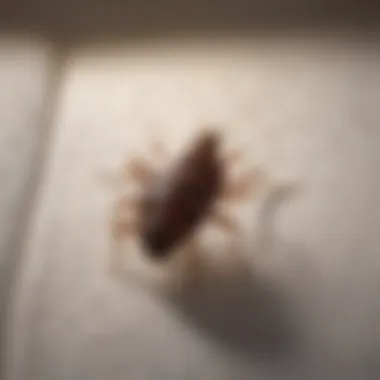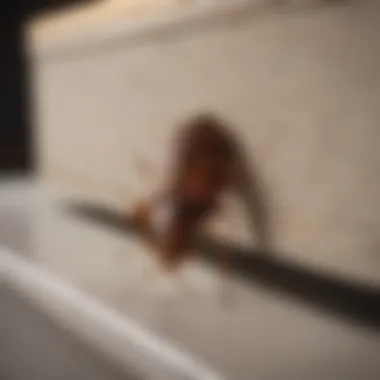Unveiling the Intricate Process of Bed Bug Detection by Exterminators


Preventive Pest Control Strategies
When it comes to safeguarding your home against bed bugs and other pests, implementing preventive pest control strategies is crucial. Starting with house exterior protection, focus on sealing cracks effectively to prevent bugs from finding their way into your home. Additionally, clearing debris around your property can eliminate potential hiding spots for pests, reducing the likelihood of infestations. To further fortify your defenses, take measures to prevent pests from entering your home by installing door sweeps and repairing damaged screens.
In terms of yard maintenance, developing essential routines such as mowing the lawn regularly and trimming shrubs can help keep your yard pest-free. By creating a well-maintained outdoor space, you can reduce the attractiveness of your property to pests. Indoors, maintaining cleanliness is paramount in pest prevention. Employ expert cleaning tips and techniques to eliminate environments conducive to pest infestations. Regular vacuuming, dusting, and decluttering can significantly decrease the likelihood of bugs taking up residence in your home.
Proper garbage disposal is another vital aspect of pest prevention. By adopting efficient waste disposal methods and ensuring that garbage bins are tightly sealed, you can deter pests from being drawn to your property. Remember that proper garbage disposal not only keeps your home clean but also reduces the risk of pest infestations. Finally, explore innovative ways to safeguard your home with additional pest prevention strategies. This could involve using natural deterrents like peppermint oil or investing in ultrasonic pest repellers to keep unwanted visitors at bay.
Overview of Bed Bugs
Bed bugs are a pervasive nuisance that have a knack for infiltrating various living spaces, causing distress and discomfort to those unfortunate enough to encounter them. Understanding the behavior and risks associated with these tiny pests is paramount for effective detection and eradication methods. This section serves as the foundation of the article, shedding light on the importance and complexity of dealing with bed bug infestations.
Understanding Bed Bug Behavior
Bed bugs exhibit a nocturnal lifestyle, preferring to remain active during the night when hosts are at their most restful state. This behavior not only enables them to feed undisturbed but also contributes to their elusive nature, making detection a challenging task for exterminators. Their preference for dark and warm environments further complicates the matter, as these conditions serve as ideal hiding spots and breeding grounds for the pests.
Nocturnal Lifestyle
The nocturnal lifestyle of bed bugs plays a fundamental role in their survival and proliferation within human habitats. By actively seeking blood meals during the night, these pests avoid detection during daylight hours, making it challenging for exterminators to locate and eliminate them effectively. This behavior is advantageous for bed bugs as it allows them to feed without interruption, facilitating their growth and reproduction within infested areas.
Preference for Dark and Warm Environments
Bed bugs gravitate towards dark and warm environments due to their optimal conditions for survival. Dark crevices and warm spaces provide the ideal shelter and breeding grounds for these pests, allowing them to thrive undisturbed. While this preference enhances their ability to establish infestations, it also poses a significant challenge for exterminators, requiring thorough inspection and treatment methods to combat their proliferation effectively.
Health Risks Associated with Bed Bugs
Beyond the annoyance they cause, bed bugs pose health risks to individuals susceptible to allergic reactions and skin irritations. Understanding these risks is vital in devising strategies to prevent and eliminate infestations effectively.


Allergic Reactions
Some individuals may experience allergic reactions to bed bug bites, manifesting as redness, itching, and swelling at the site of the bite. These reactions can vary in severity, with some individuals facing more intense symptoms than others. Identifying and addressing these allergic responses is crucial in mitigating discomfort and potential complications associated with prolonged exposure to bed bugs.
Skin Irritations
Apart from allergic reactions, bed bug bites can lead to skin irritations, causing itching and discomfort for affected individuals. These skin irritations can be persistent and may worsen over time if the infestation is not promptly addressed. Recognizing the signs of bed bug bites and associated skin irritations is essential for early detection and intervention to prevent escalating health issues.
Detection Methods
In this article, understanding the detection methods holds paramount importance as they are the frontline defense against bed bug infestations. Detection methods are crucial for identifying and confirming the presence of these elusive pests, enabling exterminators to devise effective strategies for eradication and prevention. By delving into specific elements such as visual inspections, canine inspections, and the use of monitoring devices, exterminators can accurately assess the extent of infestation and tailor treatment plans accordingly.
Visual Inspection
Checking Mattresses and Box Springs
When it comes to checking mattresses and box springs, the meticulous process involved can reveal telling signs of bed bug activity. Exterminators meticulously examine seams, folds, and crevices for live bugs, shed skins, fecal stains, and eggs, which are indicative of an infestation. This method is highly beneficial in uncovering concealed bed bugs in areas where they are likely to harbor, providing a comprehensive assessment of the situation. Although time-intensive, checking mattresses and box springs remains a popular choice due to its effectiveness in identifying early-stage infestations and preventing further spread. The thoroughness of this approach significantly enhances the accuracy of detection, helping exterminators act promptly to address the issue before it escalates.
Examining Furniture and Upholstery
Examining furniture and upholstery plays a crucial role in comprehensive bed bug inspections. Exterminators carefully scrutinize the seams, cushions, and tufts of furniture for signs of bed bugs, focusing on areas where human activity is frequent. This method allows for the detection of bed bugs in communal spaces, where infestations can quickly spread if left unchecked. The unique feature of examining furniture and upholstery lies in its ability to identify secondary infestations originating from other sources, aiding in targeted treatment measures. While this method offers advantages in spotting bed bugs in key gathering areas, the potential limitations include the challenges in accessing intricate furniture designs, necessitating meticulous attention to detail during inspections.
Canine Inspections
Training Dogs to Sniff Out Bed Bugs
Utilizing specially trained dogs to sniff out bed bugs signifies a valuable addition to the exterminator's toolkit. Dogs possess a keen sense of smell capable of detecting bed bugs even in concealed locations where visual inspections may fall short. Their ability to pinpoint infestations with precision reduces the need for extensive manual searches, streamlining the detection process significantly. Incorporating canines in bed bug inspections proves beneficial due to their efficiency in covering large areas swiftly and their accuracy in identifying even low-level infestations. The unique feature of canine inspections lies in their non-intrusive and time-saving nature, enhancing the overall efficiency of the detection procedure.
Accuracy of Canine Detection


Assessing the accuracy of canine detection is crucial in gauging the reliability of this method. Canines exhibit a remarkable success rate in detecting bed bugs, often surpassing human capabilities in identifying subtle signs of infestation. Their exceptional accuracy minimizes the risk of false negatives, ensuring a comprehensive inspection that leaves no room for oversight. The key characteristic of canine detection lies in their ability to detect bed bugs at various lifecycle stages, from eggs to adults, offering a comprehensive assessment of the infestation level. While canine detection proves highly effective, potential limitations may include the need for regular training and upkeep of the dogs' skills to maintain peak performance.
Use of Monitoring Devices
Interception Devices
Incorporating interception devices into bed bug detection strategies enhances the overall efficacy of monitoring efforts. These devices act as passive traps that intercept bed bugs as they move between host locations, providing valuable insights into their distribution patterns. The key characteristic of interception devices lies in their ability to passively capture bed bugs without the need for bait or attractants, making them a discreet yet powerful tool in monitoring infestations. Implementing interception devices is a beneficial choice for this article due to their non-intrusive nature and ability to continually monitor for bed bug activity. While interception devices offer advantages in early detection and monitoring, their effectiveness may be influenced by environmental factors and the placement of the traps, requiring strategic positioning for optimal results.
Pitfall Traps
Employing pitfall traps as a means of monitoring bed bug activity contributes significantly to detection efforts. These traps consist of containers with smooth interior walls that trap bed bugs trying to climb out after falling in. The unique feature of pitfall traps lies in their ability to passively capture bed bugs while preventing their escape, providing a simple yet effective means of monitoring infestations. Pitfall traps are a popular choice for this article due to their ease of use and ability to detect bed bugs in a wide range of settings. Despite their advantages in capturing bed bugs without the need for pesticides, pitfall traps may have limitations in detecting bed bugs in areas with limited climbing surfaces, necessitating strategic placement for optimal performance.
Confirmation Techniques
Confirmation techniques play a pivotal role in the elaborate process of bed bug detection. As professionals strive to identify and confirm the presence of these elusive pests, employing effective confirmation techniques is crucial. By utilizing specialized methods, exterminators can conclusively determine the extent of infestation and formulate the most suitable treatment plan. These techniques contribute significantly to the overall efficacy of pest control efforts by ensuring accurate detection and targeted intervention.
Taking Samples
When it comes to confirming the presence of bed bugs, taking samples is a fundamental step that offers valuable insights. The collection of bed bug specimens is a meticulous process that allows exterminators to gather tangible evidence of infestation. By carefully collecting specimens from various areas in the infested environment, professionals can analyze the severity of the problem and identify the species involved.
Collection of Bed Bug Specimens
The collection of bed bug specimens involves careful extraction and preservation of these pests for further examination. This aspect is critical as it provides concrete proof of infestation, enabling exterminators to tailor their treatment strategies accordingly. The key characteristic of this process lies in its ability to offer direct evidence of bed bug presence, aiding in accurate identification and assessment of the infestation level.
Analysis in a Laboratory Setting
Following the collection of bed bug specimens, analysis in a laboratory setting is essential for thorough evaluation. Conducting detailed examinations in a controlled environment allows for accurate species identification and assessment of potential risks. This aspect significantly enhances the overall understanding of the infestation, guiding exterminators in determining the most effective course of action.


Heat Treatments
Heat treatments represent a reliable method for eradicating bed bugs, offering a non-chemical approach to pest control. The application of high temperatures to eliminate bed bugs has gained prominence due to its efficacy and eco-friendly nature. This technique is particularly beneficial for targeted infestations in various settings, providing a swift and efficient solution to the persistent bed bug problem.
Application of High Temperatures to Eradicate Bed Bugs
The strategic application of high temperatures is a proven method for eradicating bed bugs at all life stages. By subjecting the infested area to controlled heat levels, exterminators can ensure comprehensive extermination of bed bugs without relying on chemical agents. The key characteristic of this approach is its ability to penetrate hard-to-reach areas, effectively targeting hidden bed bug populations.
Effectiveness of Thermal Remediation
The effectiveness of thermal remediation in combating bed bugs stems from its ability to deliver rapid and long-lasting results. This method not only eliminates active infestations but also disrupts the reproduction cycle of bed bugs, preventing future outbreaks. Its unique feature lies in its non-invasive nature, making it a preferred choice for eco-conscious individuals seeking efficient and sustainable pest control solutions.
Preventive Measures
Preventive measures play a crucial role in the battle against bed bug infestations. By implementing proactive strategies, individuals can minimize the risk of bed bug presence and potential infestations. Educating individuals on preventive measures is essential to empower them against these elusive pests. The benefits of preventive measures include early detection, reduced chances of infestations, and cost savings from avoiding extensive extermination efforts. Considering preventive measures involves a multifaceted approach that encompasses both education and regular inspections.
Education and Awareness
Informing Clients about Bed Bug Prevention
Informing clients about bed bug prevention is a cornerstone of effective pest management. By educating individuals on how to identify signs of bed bugs, understand their behavior, and take preventive actions, clients can actively participate in safeguarding their living spaces. This aspect contributes significantly to the overall goal of reducing infestation occurrences. The key characteristic of informing clients about bed bug prevention is its ability to empower individuals with knowledge, enabling them to take proactive measures to prevent bed bug problems. By informing clients, exterminators create an informed and proactive customer base, fostering a collaborative approach to pest control. However, one downside of solely relying on client education is the potential variation in the effectiveness of client actions, potentially leading to inadequate prevention.
Providing Tips for Avoiding Infestations
Providing tips for avoiding infestations is a practical and proactive strategy in combating bed bugs. These tips focus on creating unfavorable environments for bed bugs, such as decluttering living spaces, sealing cracks, and vacuuming regularly. By offering specific actions that individuals can take to discourage bed bug infestations, exterminators enhance the effectiveness of preventive measures. The unique feature of providing tips for avoiding infestations lies in its accessibility and simplicity, making it a popular choice for educating clients on bed bug prevention. Advantages of this approach include empowering individuals to take immediate preventive actions and fostering a sense of control over potential infestation risks. However, a potential disadvantage is that some tips may require constant vigilance and maintenance to remain effective in the long term.
Regular Inspections
Scheduled Visits by Exterminators
Scheduled visits by exterminators are a crucial component of proactive bed bug management. By conducting regular inspections, exterminators can detect early signs of bed bug presence, implement timely interventions, and prevent infestations from escalating. The key characteristic of scheduled visits is their proactive nature, which allows for continuous monitoring and rapid response to emerging bed bug threats. This approach is beneficial for ensuring comprehensive coverage of all potential infestation areas and tailoring prevention strategies to specific needs. A unique feature of scheduled visits is the personalized attention and guidance provided by experienced professionals, enhancing the effectiveness of preventive measures. While the advantages of scheduled visits are clear in prompt detection and intervention, a potential disadvantage may be the cost associated with frequent exterminator consultations.
Proactive Monitoring Strategies
Proactive monitoring strategies involve the use of surveillance tools and techniques to detect bed bugs before infestations occur. These strategies include the deployment of monitoring devices, such as traps and interception tools, in critical areas prone to bed bug activity. By actively monitoring for bed bug signs, individuals can address potential issues early and prevent widespread infestations. The key characteristic of proactive monitoring strategies is their preventive focus, allowing for preemptive actions based on surveillance results. This proactive approach is a beneficial choice for this article as it highlights the importance of proactive measures in combating bed bugs. The unique feature of proactive monitoring strategies lies in their ability to provide real-time data on bed bug activities, enabling timely responses and effective control measures. While the advantages of proactive monitoring are evident in early detection and prevention, a disadvantage may be the necessity of consistent monitoring efforts to maintain effectiveness.



